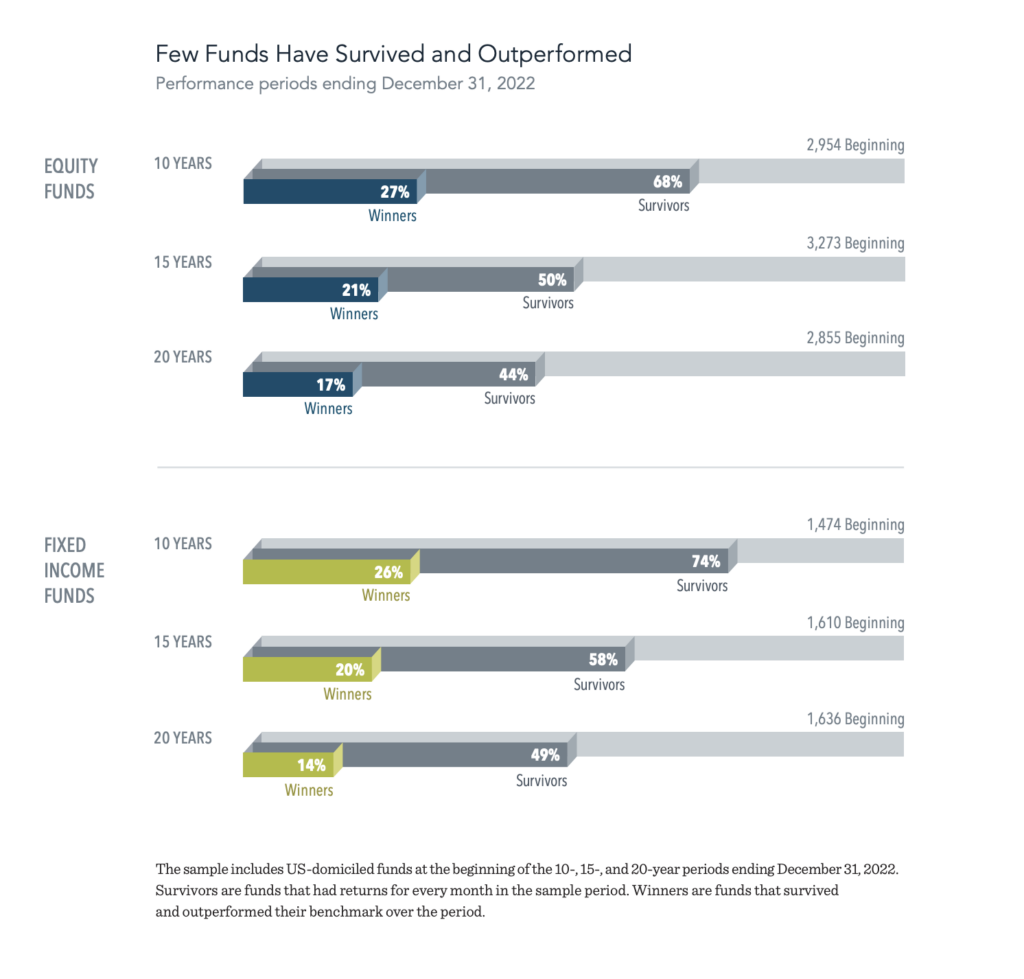Details Are Part of Our Difference
Embracing the Evidence at Anheuser-Busch – Mid 1980s
529 Best Practices
David Booth on How to Choose an Advisor
The One Minute Audio Clip You Need to Hear
Tag: Dimensional Fund Advisors
Image of the Month
Each year, Dimensional analyzes investment returns from a large sample of US-domiciled funds (over 4,000). This year’s study updates results through 2022 and includes returns from mutual funds and exchange-traded funds (ETFs) domiciled in the US. The evidence shows that a majority of fund managers in the sample failed to deliver benchmark-beating returns after costs. We believe that the results of this research provide a strong case for relying on market prices when making investment decisions.

Does Anyone Remember Inflation?

We’re fortunate inflation has been low, but that doesn’t mean we shouldn’t be prepared for its return. What are important ways we look at offsetting inflation for our clients? Our partners at Dimensional have outlined points on best practices. Read below.
Background:
- On Wednesday, January 13th the Labor Department stated that the consumer price index (CPI) increased by 0.4% in December and 1.4% for 2020, which was the smallest yearly gain since 2015 and was a significant deceleration from 2.3% in 2019.1
- However, given the $900 billion pandemic relief plan approved in December and the expectation for more fiscal stimulus, along with the rollout of the COVID-19 vaccine, some economists are forecasting a rise in inflation for the months ahead. As forecasts have moved higher, so too have market measures of inflation expectations. The 10-year breakeven rate, which is derived from prices of inflation-protected government bonds, recently climbed above 2% for the first time since 2018.2
Ways to mitigate the effects of inflation while still growing wealth:
- Commonly, equities are used as the growth asset within a portfolio and can help protect against purchasing power risk. While inflation has averaged about 4% annually over the past 50 years3, stocks (as measured by the S&P 500 Index) have returned around 11% annually during the same period.4 Therefore, the “real” (inflation-adjusted) growth rate for stocks has been around 7% per year, for the period.
- There are also tools within fixed income to hedge inflation risk including Treasury Inflation Protected Securities (TIPS). TIPS deliver the credit quality of the US Treasury, while hedging against unexpected inflation. As inflation (measured by the CPI) rises, so does the par value of TIPS, while the interest rate remains fixed. This means that if inflation unexpectedly rises, the purchasing power of any principal invested in TIPS should also increase. Dimensional’s Inflation Protected Securities Portfolio (DIPSX) launched in 2006 and has been ranked in the top quartile of its Morningstar category over the last 1-,3-,5-, and 10-years, outperforming its benchmark over each of those time periods.5
- When considering future consumption, investors may prefer a strategy that might provide higher expected returns over TIPS by investing in corporate bonds, while tax-sensitive investors may prefer a strategy that provides exposure to municipal bonds in addition to inflation protection.
Bottom Line: The good news…our clients don’t have to keep track of all these tools. That’s why we’re here for you. We stay on the cutting edge of investing and implement the best-in-class solution in an evidence-based investing world on your behalf. Curious how we can help you hedge inflation risk in your portfolio? Schedule a complimentary call with our advisory team by clicking here.
Investing Lessons from 2020

The entire world changed in countless ways in 2020. Our investing strategy did not.
Here are 10 lessons from 2020, and for the long view, that remind all of us what didn’t change in a year filled with non-stop uncertainty.
The principles outlined are timeless.
Choose an investment philosophy you can stick with for the long haul
- As Dimensional Executive Chairman and Founder David Booth says, “A philosophy serves as a compass to guide you through turbulent times. When you’ve got a compass, it doesn’t take drastic directional changes to find your way. Small adjustments are all you need to stay on course.”
- While there is no silver bullet, understanding how markets work and trusting market prices are good starting points. By adhering to a well-thought-out investment plan, ideally agreed upon in advance of periods of volatility, investors may be better able to remain calm during periods of short-term uncertainty.
Create an investment plan that aligns with your risk tolerance
- As investors, our risk appetite often changes based on the market environment we are in. In early March when we experienced the fastest bear market in history, some would have slept better at night knowing they had allocated more to bonds or cash. In April, when the market had its best monthly return since 19871, those same investors would have felt better knowing they were allocated more to stocks. The point being, you want to have a plan in place that gives you peace of mind regardless of short-term market swings.
- Over time, capital markets have rewarded investors who have taken a long-term perspective and remained disciplined in the face of short-term noise. By focusing on the aspects within their control (like having an appropriate asset allocation, diversifying their investments, and managing expenses, turnover, and taxes) and sticking to a long-term plan that is in line with their risk tolerance, investors may be better able to look past short-term noise and focus on investing in a systematic way that will help meet long-term goals.
Don’t try and time the market
- The 2020 market downturn offers an example of how the cycle of fear and greed can drive reactive decision making. Back in March, there was widespread agreement that COVID-19 would have a negative impact on the economy, but to what extent? Who would’ve guessed we would’ve experienced the fastest bear market in history in which it took just 16 trading days for the S&P 500 to close down 20% from a peak2, only to be followed by the best 50-day rally in history?3 I would be hard-pressed to find someone who had that in their market timing forecast.
- Trying to time the market based on an article from this morning’s newspaper or a segment from financial television? It’s likely that information is already reflected in prices by the time an investor can react to it. For investors trying to time the market the odds are stacked against you, the good news is, you don’t need to be able to time markets to have a positive investment experience.
Know what’s in your portfolio
- Investors want reliable portfolios with robust risk controls, unfortunately, it often takes a market decline for many to take a closer look at what is actually in their portfolio. In times of market stress, investors rely on the fixed income portion of their allocation to serve as the ballast of their portfolio, helping to provide downside protection. Many investors learned the hard way earlier this year that what they thought were safe fixed income products, were actually stretching for yield, leading to fixed income portfolios that did not hold up during the market downturn.
- We take a transparent, low-risk approach to managing fixed income – in which we are able to pursue higher returns while staying within the guardrails of the portfolio guidelines. Our investing partners perform market-informed credit assessments, providing a more complete picture of an issuer’s credit quality in real-time, helping to ensure that your portfolio behaves in a way that is commensurate with the intended credit risk exposure.
Build flexibility into your investment process – this principle is even more crucial in times of high stress
- For many, the heightened volatility we experienced this past year adversely affected trading processes as traders were forced to demand immediacy, instead of waiting for the best value, when going to the market to trade. We choose partners who approach trading differently. Dimensional’s investment and trading process, for example, is designed to function robustly and account for high volatility, changes in available liquidity, and sharp market movements. While markets were stressed and returns were somewhat unusual, the efficacy of this approach remained true and performed as expected. The approach delivered risk management in a robust fashion, delivered outperformance across many different asset classes, provided daily liquidity to investors in our portfolios throughout the period, and added value to investors.
- What was the impact on clients? In March, Dimensional was able to buy corporate bonds for 50.7 bps cheaper than the trade prior and 21.5 bps cheaper than the trade after. When going to the market to sell bonds and provide liquidity to allow clients to rebalance into equities, we were able to sell corporate bonds for 104bps higher than the trade prior and 116bps higher for the trade after.
Stay disciplined through market highs and lows
- Financial downturns are unpleasant for all market participants. When faced with short-term noise, it is easy to lose sight of the potential long-term benefits of staying invested. While no one has a crystal ball, adopting a long-term perspective can help change how investors view market volatility
Look beyond the headlines
- Read the newspaper to be an informed citizen, not for advice on how to navigate the financial markets. Daily market news and commentary are designed to challenge your investment discipline, and not in a good way. Some messages stir anxiety about the future, while others tempt you to chase the latest investment fad. The result? You buy or sell, and Wall Street gets richer. When headlines unsettle you, consider the source and maintain a long-term perspective – growing wealth has no shortcuts.
Focus on what you can control
- To have a better investment experience, people should focus on the things they can control. It starts with HIG creating an investment plan based on market principles, informed by financial science, and tailored to a client’s specific needs and goals. Along the way, we can help focus on actions that add investment value, such as managing expenses and portfolio turnover while maintaining broad diversification. Equally important, an advisor can provide knowledge and encouragement to help investors stay disciplined through various market conditions.

